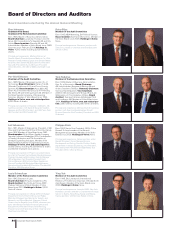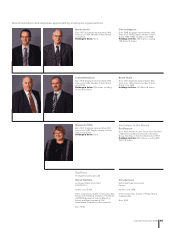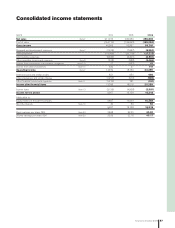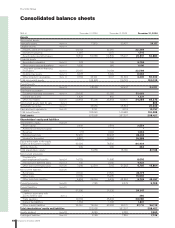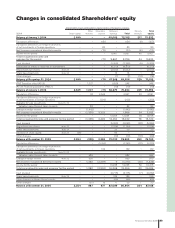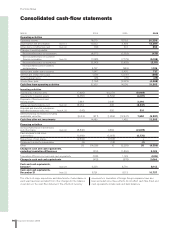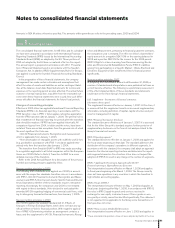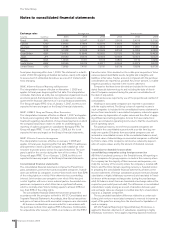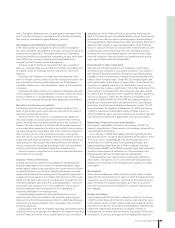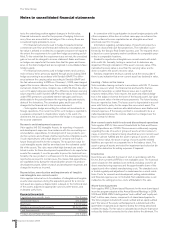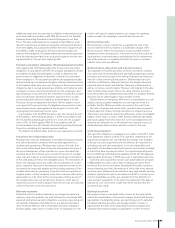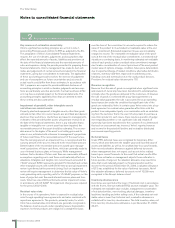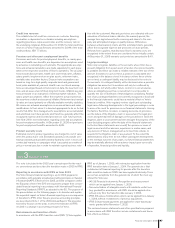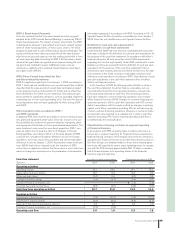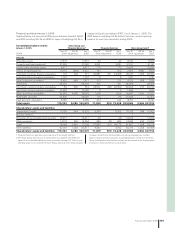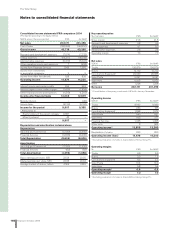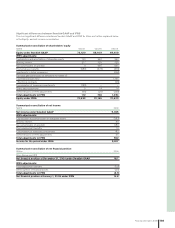Volvo 2006 Annual Report Download - page 98
Download and view the complete annual report
Please find page 98 of the 2006 Volvo annual report below. You can navigate through the pages in the report by either clicking on the pages listed below, or by using the keyword search tool below to find specific information within the annual report.
94 Financial information 2006
The Volvo Group
Notes to consolidated financial statements
tects the underlying position against changes in the fair value.
Financial instruments used for the purpose of hedging future cur-
rency fl ows are accounted for as hedges if the currency fl o ws are
considered highly probable to occur.
– For fi n ancial instruments used to hedge forecasted internal
commercial cash fl ows and forecasted electricity consumption, the
fair value is debited or credited to a separate component of equity to
the extent the requirements for cash-fl ow hedge accounting are ful-
fi l l ed. To the extent that the requirements are not met, the unrealized
gain or loss will be charged to income statement. Gains and losses
on hedges are reported at the same time that the gains and losses
arise on the items hedged and are recognized in consolidated share-
holders’ equity.
– For fi n ancial instruments used to hedge interest and currency
risks on loans, Volvo previously applied through and including 2004
hedge accounting in accordance with Swedish GAAP. The differ-
ence between the carrying value according to Swedish GAAP and
the fair value according to IFRS as of January 1, 2005, was charged
against the income statement over the remaining time of the hedged
instrument. Under the more complex rules in IAS 39, Volvo has cho-
sen not to apply hedge accounting. The difference between carrying
values reported under Swedish GAAP and fair values to be reported
under IFRS pertains to unrealized interest-rate gains and losses
attributable to the period between the reporting date and maturity
dates of the derivatives. The unrealized gains and losses will be
charged to the fi nancial net in the income statement.
– Volvo applies hedge accounting for certain net investments in
foreign operations. The current result for such hedges is reported in
a separate component in shareholders’ equity. In the event of a
divestment, the accumulated result from the hedge is recognized in
the income statement.
Research and development expenses
Volvo applies IAS 38, Intangible Assets, for reporting of research
and development expenses. In accordance with this accounting rec-
ommendation, expenditures for development of new products, pro-
duction systems and software shall be reported as intangible assets
if such expenditures with a high degree of certainty will result in
future fi n ancial benefi ts for the company. The acquisition value for
such intangible assets shall be amortized over the estimated useful
life of the assets. The rules means that high demands are estab-
lished in order for these development expenditures to be reported as
assets. For example, it must be possible to prove the technical func-
tionality of a new product or software prior to this development being
reported as an asset. In normal cases, this means that expenditures
are capitalized only during the industrialization phase of a product
development project. Other research and development expenses are
charged to income as incurred.
Depreciation, amortization and impairments of tangible
and intangible non-current assets
Volvo applies historical costs for valuation of intangible and tangible
assets. Loan expenses during the acquisition period for a non-cur-
rent asset are expenses. Depreciation is based on the historical cost
of the assets, adjusted in appropriate cases by write-downs, and
estimated useful lives.
Depreciation periods
Capitalized type-specifi c tools 2 to 8 years
Operational leases 3 to 5 years
Machinery 5 to 20 years
Buildings and Investment property 25 to 50 years
Land improvements 20 years
Product and software development 3 to 8 years
In connection with its participation in aircraft engine projects with
other companies, Volvo Aero in certain cases pays an entrance fee.
These entrance fees are capitalized as an intangible asset and
amortized over 5 to 10 years.
Information regarding estimated value of investment property is
based on discounted cash fl ow projections. The estimation is per-
formed by the Group’s Real Estate business unit. The required return
is based on current property market conditions for comparable prop-
erties in comparable locations.
Goodwill is reported as intangible non-current assets with inde f-
inite useful life. Annually, testing is carried out to determine any
impairment through calculation of the asset’s recovery value. If the
calculated recovery value is less than the carrying value, a write
down is made to the asset’s recovery value.
Similarly, impairment testing is carried out at the closing date if
there is any indication that a non-current asset has declined in value.
Leasing – Volvo as the lessee
Volvo evaluates leasing contracts in accordance with IAS 17, Leases.
In those cases in which the fi n ancial risk and benefi ts that are
related to ownership, so called fi nance lease, are in signifi cant
respects held by Volvo, Volvo reports the asset and related obliga-
tion in the balance sheet at the lower of the leased asset’s fair value
or the present value of minimum lease payments. The future leasing
fees are reported as loans. The lease asset is depreciated in accord-
ance with Volvo’s policy for the respective non-current asset. The
lease payments when made are allocated between amortization and
interest expenses. If the leasing contract is considered to be a so
called operational lease the income statement is charged over the
lease contract’s lifetime.
Non-current assets held for sale and discontinued operations
Volvo applies IFRS 5, Non-current Assets Held for Sale and Discon-
tinued Operations as of 2005. Processes are continuously ongoing
regarding the sale of assets or groups of assets at minor values. In
cases in which the criteria for being classifi ed as a non-current asset
held for sale are fulfi lled and the asset or group of assets is other
than of minor value, the asset or group of assets and the related
l iabilities are reported on a separate line in the balance sheet. The
asset or group of assets are tested for impairment and valued at fair
value after deduction for selling expenses if impaired.
Inventories
Inventories are stated at the lower of cost, in accordance with the
fi r s t-in, fi r st-out method (FIFO), or net realizable value. The historical
value is based on the standard cost method, including costs for all
direct manufacturing expenses and the apportionable share of the
capacity and other related manufacturing costs. The standard costs
is tested regularly and adjustment is made based on current condi-
tions. Costs for research and development, selling, administration
and fi n ancial expenses are not included. Net realizable value is cal-
culated as the selling price less costs attributable to the sale.
Share-based payments
Volvo applies IFRS 2, Share-based Payments for the new share-based
incentive program adopted at the Annual General Meetings in 2004,
2005 and 2006. IFRS 2 distinguishes “cash-settled” and “equity-set-
tled”, in Volvo case, shares, components of share-based payments.
The Volvo program include both a cash-settled and an equity-settled
part. The value of the equity-settled payments is determined at the
grant-date, recognized as an expense during the vesting period and
credited to equity. The fair value is calculated according to share price
reduced by dividend connected to the share before the allotment. The


